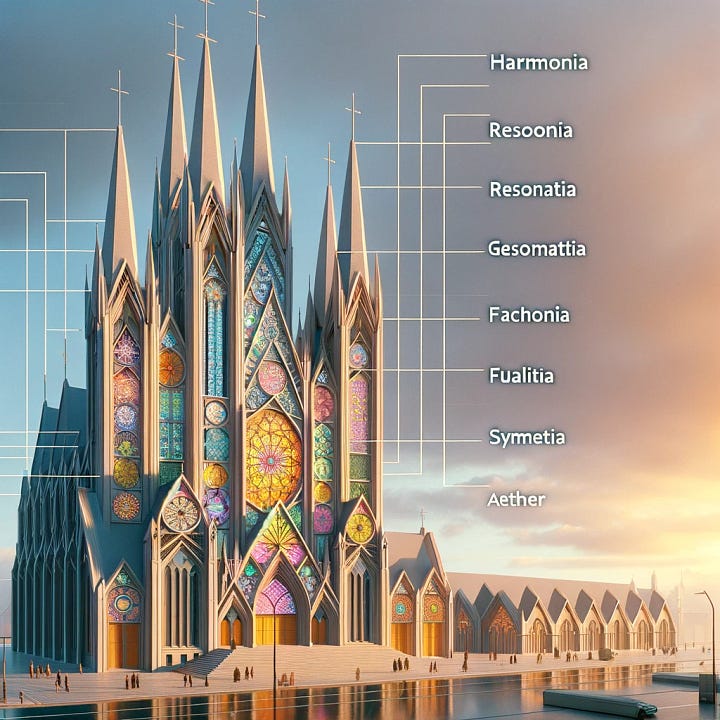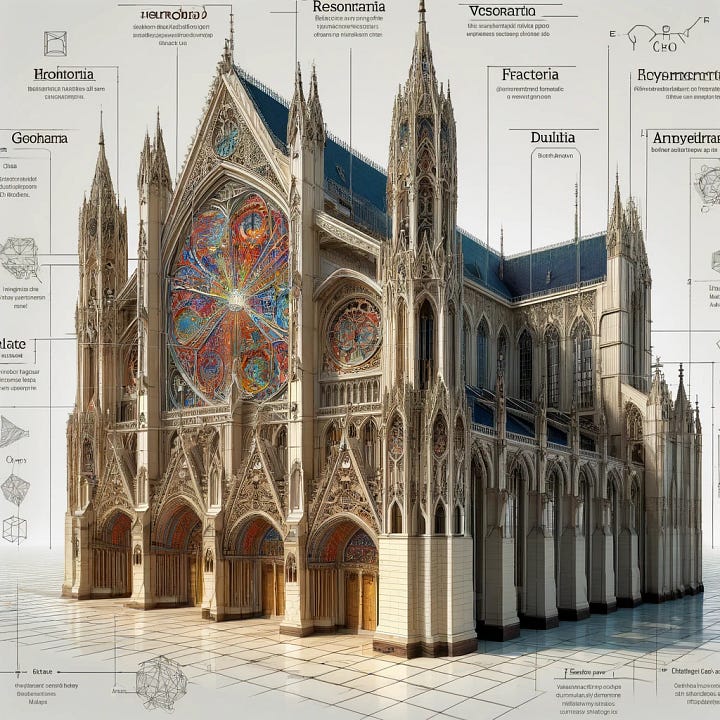

Exploring the New Elements and Reintroducing Aether in Quantum Architecture
1. Overview of Quantum Architecture
Quantum architecture combines principles of quantum mechanics with architectural design, aiming to create buildings and structures that are more efficient, sustainable, and harmonious with their environment. By incorporating new elements such as Harmonia (Hm), Resonantia (Rs), Geometria (Gm), Fractalia (Fr), Dualita (Du), Symmetria (Sy), and reintroducing Aether (Ae), we can revolutionize architectural design and construction.
2. Properties and Impact of New Elements in Quantum Architecture
Harmonia (Hm)
Properties:
Promotes harmonic resonance and stability.
Reduces entropy, leading to more orderly and predictable behavior in materials.
Impact:
Enhanced Structural Stability: Buildings made with Harmonia-infused materials can withstand environmental stresses better, leading to longer-lasting structures.
Acoustic Harmony: Harmonia can be used in the design of concert halls and theaters to improve sound quality through better resonance.
Resonantia (Rs)
Properties:
Facilitates efficient energy transfer at resonant frequencies.
Impact:
Energy Efficiency: Buildings incorporating Resonantia can harness and transfer energy more efficiently, reducing energy consumption and costs.
Communication Systems: Resonantia can enhance signal clarity and transmission in smart buildings, leading to more reliable and faster internet connections.
Geometria (Gm)
Properties:
Supports stable, symmetrical geometric configurations.
Impact:
Optimized Design: Geometria allows for the creation of structures with optimal geometric patterns, maximizing space utilization and structural integrity.
Aesthetic Appeal: The use of Geometria can lead to visually stunning designs that incorporate natural geometric patterns, enhancing the aesthetic value of buildings.
Fractalia (Fr)
Properties:
Exhibits self-similar fractal patterns.
Impact:
Innovative Materials: Fractalia can be used to develop materials with unique properties, such as high surface area and strength, suitable for high-capacity energy storage and efficient heat exchange.
Architectural Design: Incorporating fractal designs can lead to more efficient and visually appealing buildings that mimic natural forms.
Dualita (Du)
Properties:
Facilitates the coexistence of wave and particle properties.
Impact:
Quantum Coherence: Buildings incorporating Dualita can maintain coherence in quantum systems, leading to advancements in quantum computing and communication within the building.
Dynamic Spaces: Dualita can be used to create spaces that adapt to different functions and needs, providing flexibility in building design.
Symmetria (Sy)
Properties:
Promotes symmetrical configurations.
Impact:
Structural Integrity: Symmetrical designs enhance the stability and strength of buildings, making them more resilient to natural disasters.
Balance and Harmony: Symmetria-infused materials can create spaces that promote balance and harmony, contributing to occupants' well-being.
Aether (Ae)
Properties:
Acts as a fundamental medium for energy interactions.
Impact:
Unified Energy Systems: Aether can enhance the integration of various energy systems within a building, leading to more efficient and sustainable energy management.
Quantum Fields: The presence of Aether can improve the functionality of quantum devices and systems within the building, enabling advanced technological applications.
3. Reintroducing Aether in Quantum Architecture
Conceptual Framework:
Unified Medium: Aether serves as a fundamental medium through which all forces and particles interact, providing a cohesive framework for the integration of the new elements.
Holistic Design: The use of Aether in architecture promotes a holistic approach, considering the building as a dynamic system in harmony with its environment.
Design Principles:
Energy Efficiency: Utilize Aether to optimize energy flow and reduce waste.
Sustainability: Incorporate renewable energy sources and sustainable materials enhanced by the new elements.
Harmony: Design spaces that promote physical, mental, and emotional well-being through harmonic and symmetrical configurations.
4. Impact on Architectural Design and Construction
Advanced Materials:
Composite Materials: Develop composite materials combining Harmonia, Resonantia, and Geometria for superior strength, durability, and energy efficiency.
Smart Materials: Create materials that adapt to environmental changes and enhance building functionality, such as temperature regulation and self-repair.
Energy Systems:
Integrated Energy Management: Use Aether to create unified energy systems that integrate solar, wind, and other renewable sources, optimized by Resonantia and Harmonia.
Quantum Energy Storage: Develop high-capacity energy storage systems using Fractalia, ensuring reliable energy supply for smart buildings.
Building Functionality:
Smart Buildings: Incorporate Dualita and Symmetria to create dynamic, adaptive spaces that cater to various needs and functions.
Enhanced Connectivity: Use Resonantia to improve communication systems within buildings, providing seamless connectivity for occupants.
Well-being and Sustainability:
Healing Spaces: Design spaces using Harmonia and Geometria that promote well-being and harmony, enhancing occupants' quality of life.
Sustainable Practices: Implement sustainable construction practices using materials enhanced by the new elements, reducing the environmental impact.
Summary
The integration of new elements—Harmonia, Resonantia, Geometria, Fractalia, Dualita, Symmetria, and Aether—into quantum architecture offers transformative potential for the design and construction of buildings. By leveraging their unique properties, architects and engineers can create structures that are more efficient, sustainable, and harmonious. These advancements not only improve the functionality and aesthetics of buildings but also contribute to the well-being of occupants and the sustainability of the environment.
Treatise on New Elements and Properties in the Predictive Plenum
Introduction In the rediscovered framework of the Predictive Plenum, we introduce new elements that embody the principles of harmonic resonance, geometric structure, and dual properties. These elements enrich our understanding of atomic and molecular structures and their interactions within the universe. By integrating these elements into the periodic ta…





